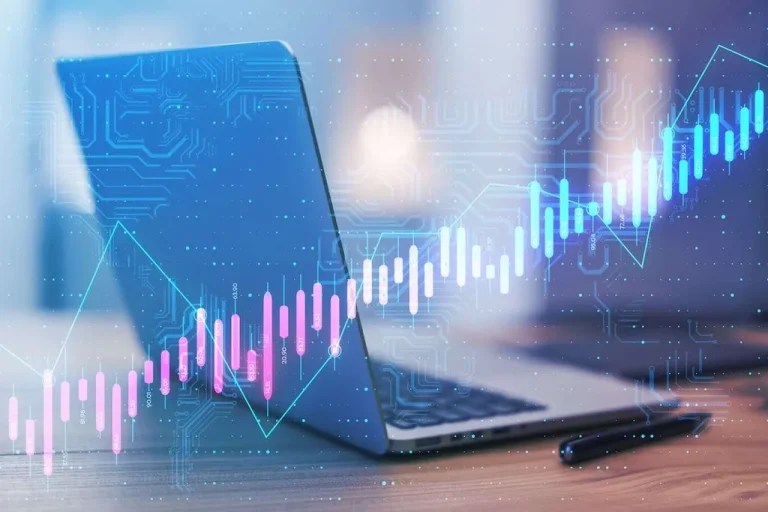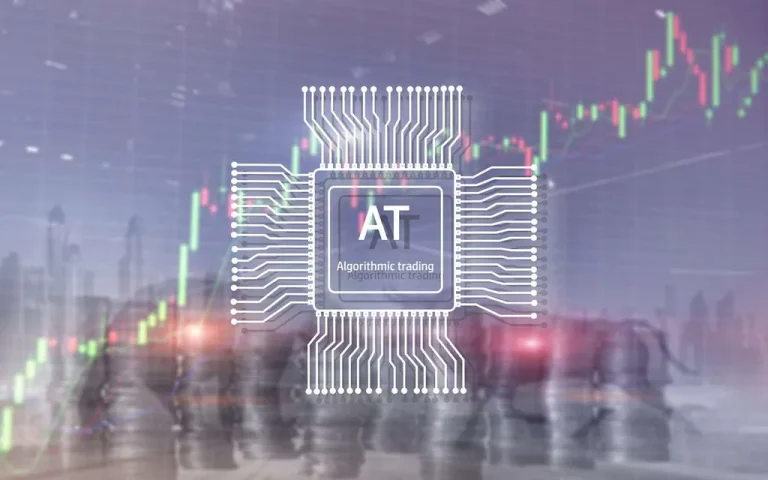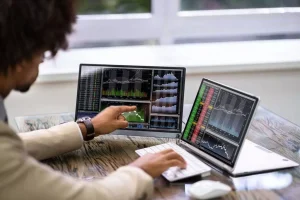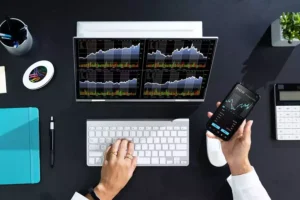Ensuring profitability in a rapidly transforming environment is an arduous task. Volatility spikes are challenging to exploit without utilizing dedicated digital solutions. Algo trading involves using programming and an ultra-fast connection to financial markets to execute trades in milliseconds under specific conditions. Employing cutting-edge services, mastering technical analysis, and customizing algorithms ensure success.
In this article, we will delve into the intricacies of automated trading and explain what strategies allow top earners to minimize risks. Also, we will explore how exploiting arbitrage, index fund rebalancing, and divergences with average prices (AP) facilitates locking in gains.
How Algorithmic Trading Works
Ensuring that human emotions don’t slow down the decision-making process makes it easier to place orders. Leveraging quantitative modeling and analysis, algo trading minimizes risks related to stock market investments. Implementing algorithm-based strategies requires an extensive coding background. Embracing the systemic and well-structured trading approach simplifies discovering potentially profitable deals and executing them without any delays.
Earning money necessitates utilizing dedicated software, ensuring stable network access, getting insights about the situation in financial markets, and using coding skills.
Algo based trading functions in the following way:
- A program purchases shares when the 50-day moving average (MA) exceeds the corresponding 200-day MA.
- Shares are sold when the 50-day MA gets lower than the 200-day MA.
Traders may utilize other guidelines and configure the software to track prices and other indicators. This way, they do not have to place orders manually or constantly monitor changes.


Turnkey Brokerage Solution For Your Business
Get the most profitable fully licensed fx/crypto brokerage software or ready-to-operate business in 48 hours. Best-in-class web & mobile trading platforms, sales-driven CRM, full integration with MT4/5, and 150+ payment providers.
Advantages and Disadvantages of Algorithmic Trading
Finding an opportunity to execute trades in the best possible conditions becomes easier due to the usage of black-box trading strategies. They have multiple notable benefits:
- Result-yielding execution: Orders are filled to maximize profits.
- Minimal latency: Trades are completed in a tick.
- Low transaction fees: Algorithms select the most money-spinning conditions.
- Risk-free transactions: Reducing the possibility of human error brings enhanced results.
- Backtesting: Utilizing high-quality data facilitates employing strategies under different conditions to check their sustainability.
However, the opponents of the approach argue that it has limitations. Here are its main shortcomings:
- Regulatory compliance issues: Algos deployment is heavily regulated, so it may be tough to meet all the requirements.
- Difficulties with achieving low latency: If a trader lacks access to solutions ensuring fast data transfer, it causes delays and results in losses.
- Costly hardware and software: Implementing the strategy requires paying hefty fees to access digital products and data feeds.
- Unforeseen events: Tested in controlled environments, algos fail when unpredictable changes occur.
Even though the method is unbiased, it may be impossible to customize algos to ensure they will function flawlessly in changing circumstances.
What are the Main Algorithmic Trading Strategies?
Utilizing advanced tools capable of analyzing current market situations, evaluating risks, and making decisions about placing an order in a fraction of a second is only the first step toward increasing the profitability of algo trading.
Finding the right moment and speculating on minuscule price differences requires ventures to learn how to deploy a multitude of auto trading strategies.
Trend following
Capturing quick fluctuations becomes possible through the calculation of 50- and 200-day moving averages (MAs). The appeal of the streamlined plan lies in its simplicity. There is no need to delve into the depth of predictive analytics, as algorithmic solutions facilitate detecting specific trends and highlighting the good time to make lucrative deals.
This approach relies on following trends in MAs utilizing a host of signals. Noticing when stock prices go outside a specific support or resistance level is pivotal, as it allows dealers to detect channel breakouts in time. There is no need to rely on vague forecasts, as the method enables investors to get enough information to notice subtle movements signifying upcoming changes in trends.

Speculating on arbitrage deals
As some markets are slow to adjust their info, purchasing one stock at an exchange and simultaneously selling it at a higher bid at another trading platform is the surest way to boost profits without facing any adverse effects. Algorithms are quick to discover differently priced stocks and automatically make deals to speculate on dual-listed assets.
Arbitrage deals are almost risk-free, so many traders are tempted to purchase stocks on foreign platforms where they are sold cheaper due to the exchange rate.
Technical analysis
Investors leverage specific algorithms to make deals based on specified parameters. For instance, when volatility rapidly increases, algorithm-based services close positions automatically to mitigate risks. Employing this strategy implies using a variety of tools:
- Bollinger bands;
- MACD;
- Momentum indicators;
- RSI.
Conducting in-depth research is necessary to learn how to make the most out of commonly used technical tools. The efficacy of a chosen approach depends on an investor’s readiness to risk. The key benefit of the technique is its focus on indicators when it comes to triggering buy and sell operations.
Price action
This basic plan of action involves comparing past data about open and closing prices and triggering actions when similar conditions are met. When a price goes higher or falls lower at a specified point, an algorithm automatically buys or sells assets, depending on its instructions.
Known as high frequency trading (HFT), this method yields high profits in volatile markets. Reducing risks requires putting limits and tweaking other parameters of the algorithm to achieve the desired result.
This strategy can be used together with technical analysis to make more accurate predictions about the development of the situation. Making subtle adjustments depending on the circumstances, establishing the time frame, and specifying other parameters facilitates increasing efficiency.
Index rebalancing
When stocks are purchased and sold, these operations result in a disbalance. Capitalizing on it involves taking an active part in rebalancing, which involves buying and selling assets once they get priced differently.
As index funds have to perform rebalancing within a specified time frame, merchants earn money on expected transactions. Algorithmic systems automatically trigger such trades in microseconds when conditions are met.
Delta-neutral trading
Mathematical models offer a wealth of opportunities. They enable the creation of positions that won’t be significantly impacted by changes. It becomes possible by reducing the delta value of a position almost to zero.
This time-tested method facilitates trading on a variety of assets. Achieving a delta-neutral position requires purchasing or selling options and then performing the opposite operation to reduce the accumulated delta of the deal.
Mean reversion
This tactic enables investors to capitalize on prices that have greatly increased or decreased from their historical mean value. The approach is grounded on the theory that prices tend to remain near their long-term average levels.
Utilizing statistical analysis tools, users estimate a Z-score to see how much a price has deviated. After finding a pair of correlated stocks, they wait until the price ratio between them starts to differ from their average.
Analyzing volatility is also crucial for making an accurate prediction about the likelihood of the price reverting to the mean. Proponents of the approach utilize mathematics models to minimize their risks and foresee price movements.

VWAP and TWAP
The first method involves calculating the Volume-Weighted Average using a ratio of the average asset price compared to the total volume of assets bought or sold during a specific time. After multiplying a price by the volume, traders need to divide it by the number of the total shares. VWAP is utilized by swing and position traders using it similarly to an MA.
Another strategy involves dividing the total value of an asset traded during a specific timeframe by the total number of shares bought or sold during that time. Calculating the Time Weighted Average Price requires measuring the AP and executing orders close to it to minimize risks.
Strategies involving sniffing algorithms
FINRA regulates the usage of front-running practices. Even though they may be considered illegal, some tools can identify the usage of algorithmic bots on the buy side. The method facilitates discovering profitable chances for dealers seeking to fill large orders at a high price.
Technical Requirements for Algorithmic Trading
After building and configuring software, traders perform thorough testing and check whether the algorithm allows making profitable deals based on historical data.
Gaining in-depth knowledge of algorithmic trading technology is a must to minimize risks related to the usage of tools on stock markets. Discovering how to build a program based on a specific trading strategy is the most laborious process automation task. Here are the key requirements:
- Extensive background in programming to configure a trading strategy, the usage of advanced dedicated software, or a team of professionals capable of configuring an algorithm;
- An ultra-high network speed allows a program to access an exchange and perform operations with zero latency;
- The availability of market data feeds to discover the right set of circumstances;
- The infrastructure is necessary for testing the algorithm in a controlled environment before deploying it online.
Besides, it is necessary to ensure access to historical data to test the tool’s effectiveness under different scenarios.
An Example of Algorithmic Trading
The steps necessary for achieving success depend on the type of asset and other parameters. Deploying a crypto trading algorithm to implement a triangular arbitrage strategy includes the following steps:
- Find opportunities: Employ an algorithm to screen three markets with different exchange rates and discover price discrepancies.
- Execute orders: Using automated tools, buy and sell orders to speculate on an asset’s price differences. Ensure that your orders are matched to avoid partial fills.
- Calculate arbitrage profits: Compare the initial investment to the final amount to assess the profitability of the trade.
- Adjust the strategy: If the outcomes are unsatisfactory, refine the algorithms based on performance metrics.
Keep in mind that transaction costs may significantly impact your gains. Besides, the market should have enough liquidity to allow you to place large orders.
Conclusion
The success of algo trading heavily relies on the usage of powerful software and ensuring quick access to exchanges to facilitate code execution. When customizing their tools, traders and investors specify open and close times to enjoy maximum gain. Algorithms must be constantly upgraded, necessitating high-volume investments in the infrastructure. As with any type of strategy, an algo-based approach is not devoid of risks. However, it enables traders to get ahead of competitors and reap substantial rewards.






